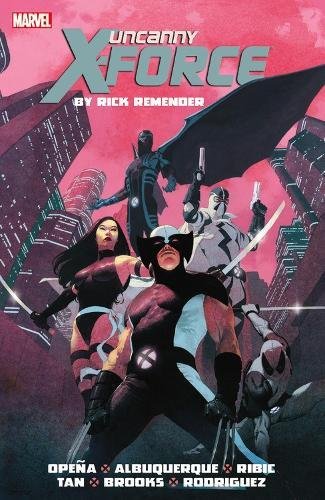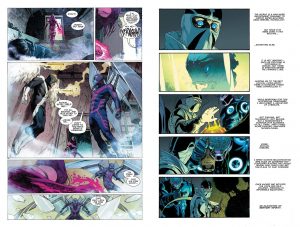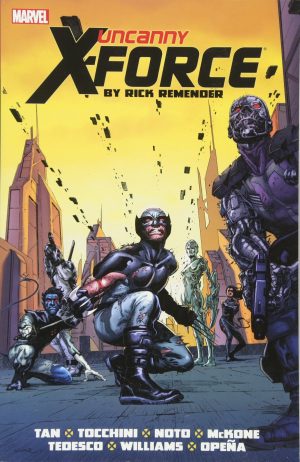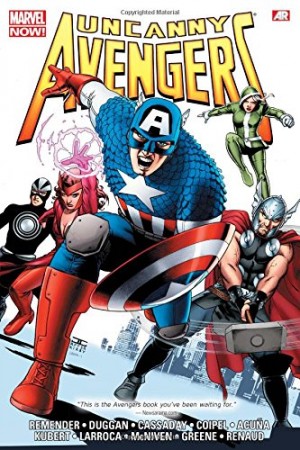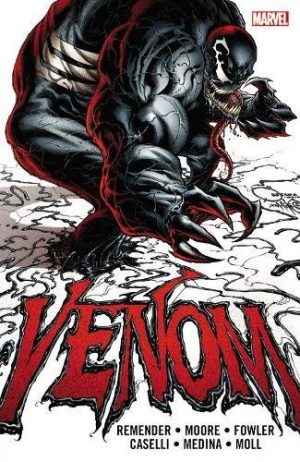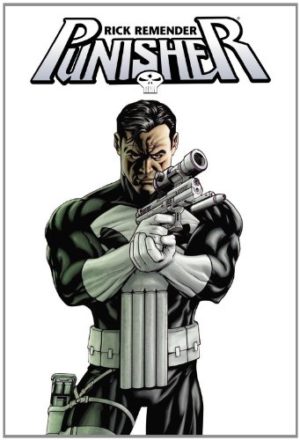Review by Ian Keogh
Marvel’s bulky Complete Collection paperbacks generally consist of an arbitrary presentation of consecutively issued comics. This is different. It’s not always apparent, but what’s provided here is a single twenty chapter story where people have a starting point and are altered by their experiences on the road to the end. It’s broken down into individual sequences to serve the needs of monthly publication, these involving separate threats, whereas the emotional drama established from the start continually escalates until it snaps in several places.
Rick Remender picked up the already established idea of X-Force being the X-Men’s black-ops team, carrying out missions likely to require killing, and keeping their activities secret from the other X-Men. He modified that team, adding Deadpool, whose wittering dialogue he writes very well, and Fantomex, who along with Angel is key to the entire story. Fantomex is the end product of the super soldier project, a perfect combat specimen genetically engineered who escaped from his hidden environment, known as the World, shrunk it, and keeps it in his hideout. Angel is an original X-Man, but for a period was one of uber-villain Apocalypse’s Four Horsemen as Archangel. He can still transform into that identity, and is finding it increasingly difficult to keep Archangel’s personality suppressed. Essential to that process is his telepathic girlfriend Psylocke. Their first team mission ends with someone doing the unthinkable, and the consequences reverberate throughout these stories.
Artistically this is a stunning collection. In fact as superhero comics go you’d be hard pressed to find a better drawn selection of nineteen consecutive comics, with only the distorted figures of Robbi Rodriguez on the epilogue chapter disappointing. Jerome Opeña sets the standard very high, and eventually draws more pages than any other artist. He has a phenomenal sense of page design, both with regard to viewpoints and the designs within the panels, and is also a great storyteller. Esad Ribić hasn’t quite drifted into the imposing style later used for Thor, but he’s on the way, and his pages are mighty impressive (sample spread right), yet the same applies to Mark Brooks and Billy Tan, who also draw three chapters apiece.
There is a point during the introduction of Deathlok where Remender becomes bogged down in too much technobabble, but it passes quickly, and reading the entire book as a whole it’s impressive how many seeds randomly planted come to fruition by the end. He has a tendency to presume a significant knowledge of earlier X-Men related events on the part of readers, but most readers should be able to go with the flow and realise, for instance, that the Age of Apocalypse features a very different bunch of X-Men, some no longer fighting the good fight.
By the end that also seems to be the case for some of X-Force, but the final thrilling segment of ‘The Dark Angel Saga’ is a great resolution to everything that’s been built up. Remender starts again in Vol. 2, while this content was previously released in hardcover as The Apocalypse Solution, Deathlok Nation, and Book One and Book Two of The Dark Angel Saga. All are also combined for Uncanny X-Force by Rick Remender Omnibus.
